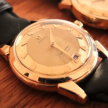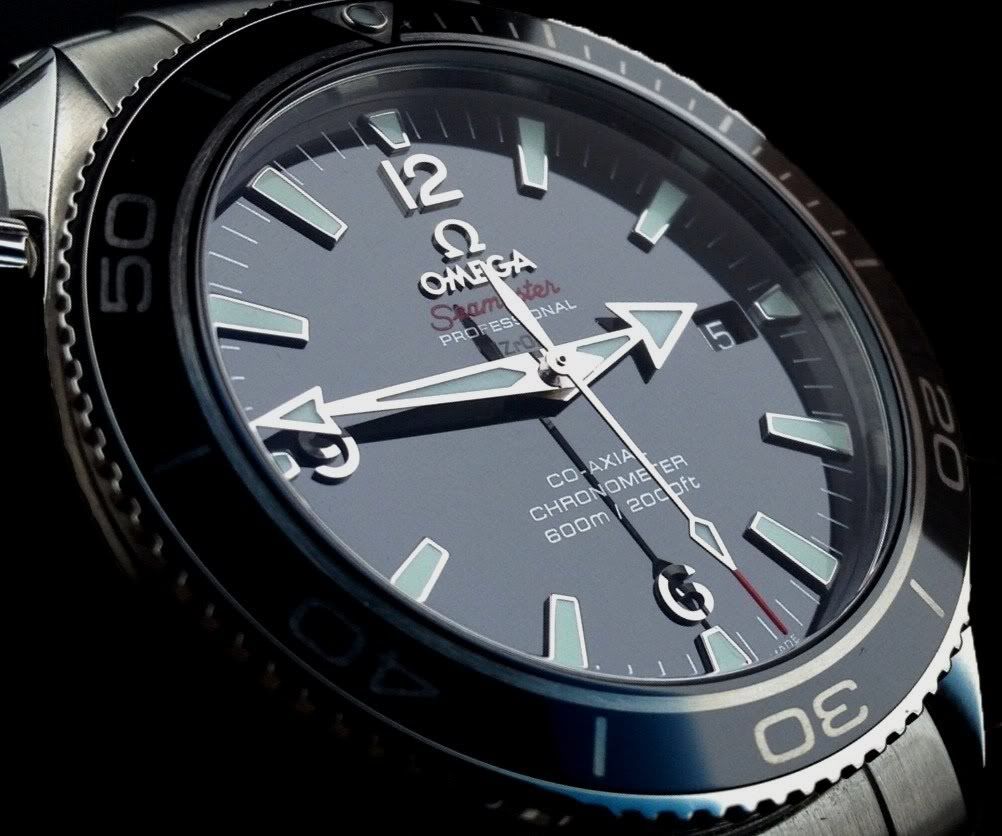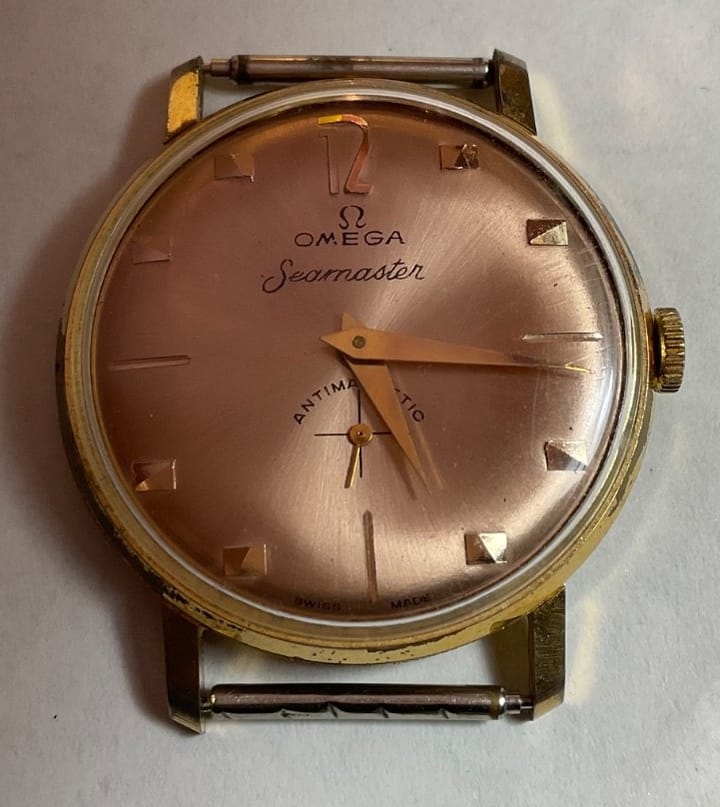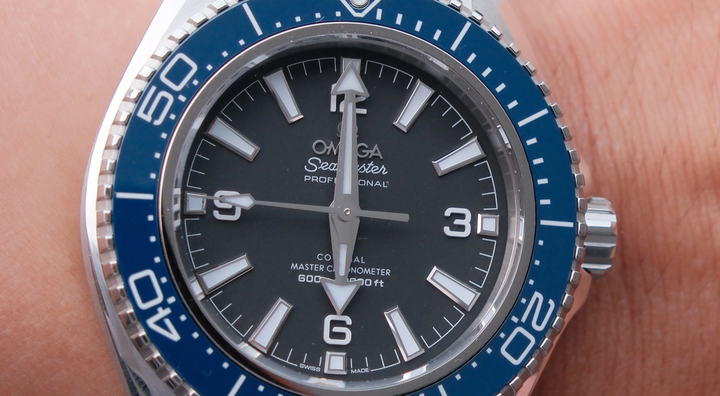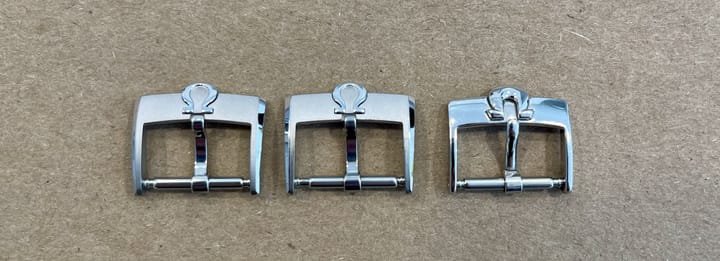A Statement of Intent
By the late 2000s, Omega had been doing very well selling high quality, well finished watches with Co-Axial movements. In 2007, they demonstrated their vision for moving the brand to higher quality, in-house produced, Co-Axial movements with the debut of the Hour-Vision powered by Calibre 8500.
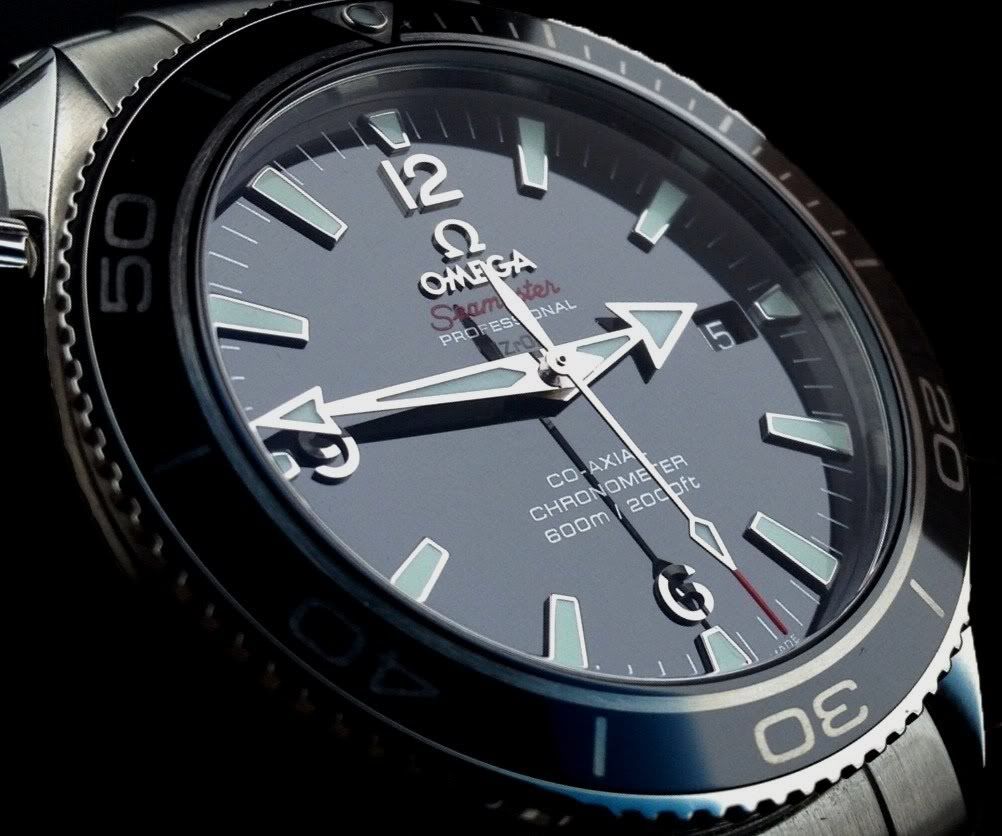
Like the Hour-Vision, the Seamaster Planet Ocean Liquid Metal Limited Edition Reference 222.30.42.20.01.001 was a blueprint for the future of the company, a demonstration of how committed the brand was to innovation in materials science. More significantly than that, it was an enormous step up in quality of finishing, so great that it could be seen clearly without need of a loupe. The Liquidmetal LE threw down the gauntlet to Omega's competitors at the perfect time, and signaled the level luxury divers would need to compete at into the 2010s.
It also happened to be released at a time when arch rival Rolex was still producing the rather outdated 16610 Submariner, complete with aluminium bezel and stamped metal clasp. The juxtaposition between the Liquidmetal LE and its competitor never seemed to stark.
Through its history, Omega has never prospered by sitting still. During the brand's golden era of the 1940s through to the late 1960s, Omega had always been about experimentation, innovation, exploring niche scientific and engineering challenges and pushing the envelope. The Planet Ocean Liquidmetal Limited Edition was a perfect example of that in 2009, a raising of the bar combined with multiple new technologies to produce something greater than the some of its parts.
Liquidmetal & Zirconium Dioxide (ZrO2)
It's worth understanding these two materials which set the Planet Ocean Liquid Metal LE apart from all prior Omegas in order to appreciate the significance of the watch as a technology demonstration. In the years that followed the release of this model, Omega invested heavily in ceramic bezels, dials and Liquidmetal inlays across the entire Omega product range.
Over time, this expanded into several entirely ceramic Omega watches, incredibly vibrant colors and no doubt more novelties yet to come in the future.
Zirconium Dioxide (ZrO2)
Zirconium Dioxide is the material Omega is referring to whenever they use the term ceramic in relation to dials, bezels and more recently even cases. Also known as zirconia, the material is widely used in many industries and has been for a very long time, in everything from dentistry, to electronics to industrial engineering, while cubic zirconia is known for its use as a diamond substitute.
Unlike Liquidmetal, ZrO2 requires no license to use and exists in many forms in the watch industry, most often used in dials and bezels for a variety of brands today, including Rolex which markets the material used in their bezels as "Cerachrom".
While ZrO2 itself is widely used, the exact chemistry and processes behind the application of color pigments and production techniques do vary greatly along with the capabilities of each manufacturer. This is where being a part of Swatch Group becomes extremely beneficial for Omega.
One of Omega's stablemates within the Swatch Group is a little known and poorly understood company called Comadur SA, a powerhouse materials and ceramics specialist based out of Le Locle. The niche expertise of Comadur has enabled Swatch Group brands like Omega to develop stunning dials, bezels and even entire cases as on the Omega Dark Side of The Moon while maintaining high standards of durability. In recent years they've even been able to produce incredibly rich colors and combine them with embedded super-luminova in bezels and crowns.
Liquidmetal
Unlike ZrO2, Liquidmetal is a commercial trade name that actually refers to a group of amorphous metal alloys with slightly differing properties, developed by a team at the California Institute of Technology and marketed by Liquidmetal Technologies.
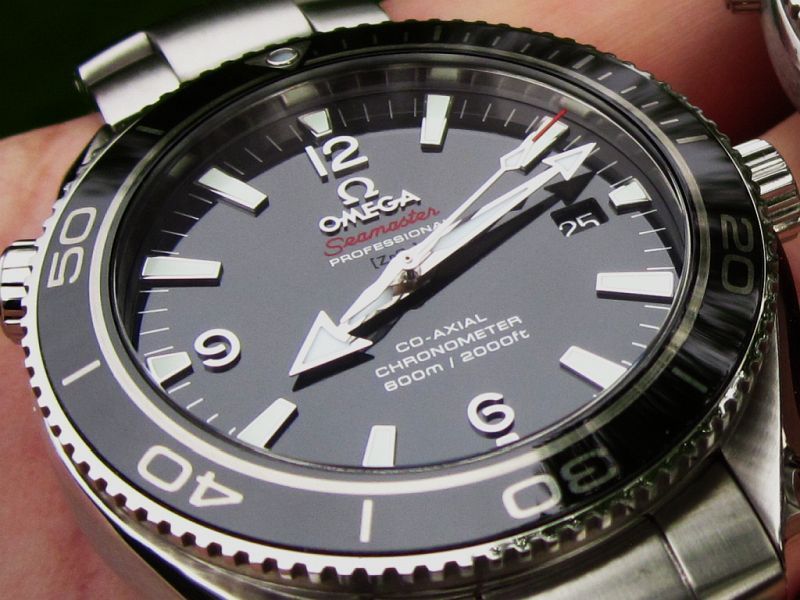
In 2011, Omega & Comadur's parent company Swatch Group signed an exclusive licensing agreement with Liquidmetal Technologies and since then, the use of Liquidmetal in conjunction with ceramics has exploded across Omega's model range. In the 13 years since the release of the Planet Ocean LM LE, the material has proven to be extremely resilient, durable and ideal for its purpose.
The primary use of Liquidmetal for Omega is in bezels, where it is used to provide contrasting indices against the ceramic color. Comadur begins by producing the bezel out of ZrO2 with small recesses where the diving indices and numbers would go. The Liquidmetal is then pressed and bonded into the ceramic, then polished off until a perfectly flush seamless finish is left behind. The resulting indices are smooth to the touch, of similar hardness to the ceramic, and have a sharpness and contrast that is impossible to achieve any other way.

While Omega was the first to use Liquidmetal via Comadur, it was not the only Swatch Group member to utilize the material. Breguet released the Reveil musical in 2010 also with Liquidmetal used in an entirely different way, to better reproduce a music-box type sound effect. No doubt experimentation within the group will continue and more interesting uses will come to light as time goes on.
Case & Bracelet
The Seamaster Planet Ocean 42 mm case used in the standard calibre 2500 is effectively identical to the Liquid Metal Limited Edition's. There is no 45.5 mm XL version of the Ref 222.30.42.20.01.001, nor are there any other metals, nor is there a strap version. All watches were identical at 42 mm diameter, 14.5 mm thick and with 20 mm lugs.
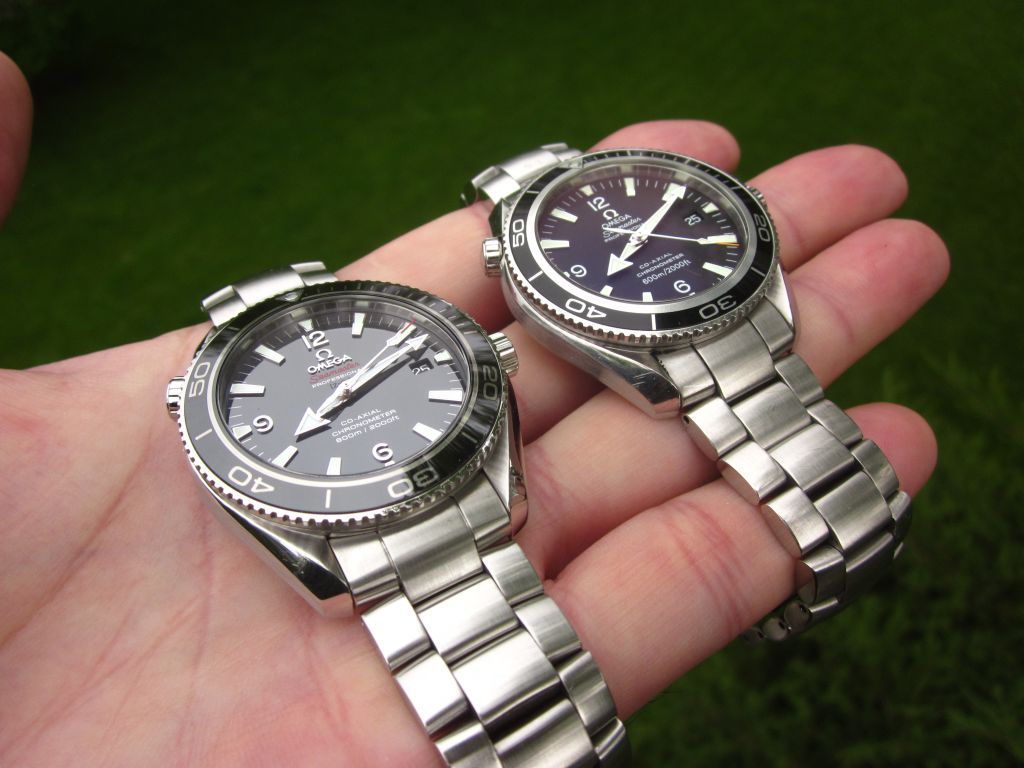
The Planet Ocean case carries the traditional twisted lugs first seen on the Seamaster 300 diver models of the 1960s, in an asymmetrical case with integral crown guards derived from the Speedmaster Pro Moonwatch case rather than the Seamater Pro 300M. It's easy to miss this small element that differentiates the Planet Ocean from the Bond Seamaster case but the Seamaster Pro 300M really does have crown-guards that sit proud of the case on their own while the Planet Ocean is effectively a Moonwatch case without pushers.
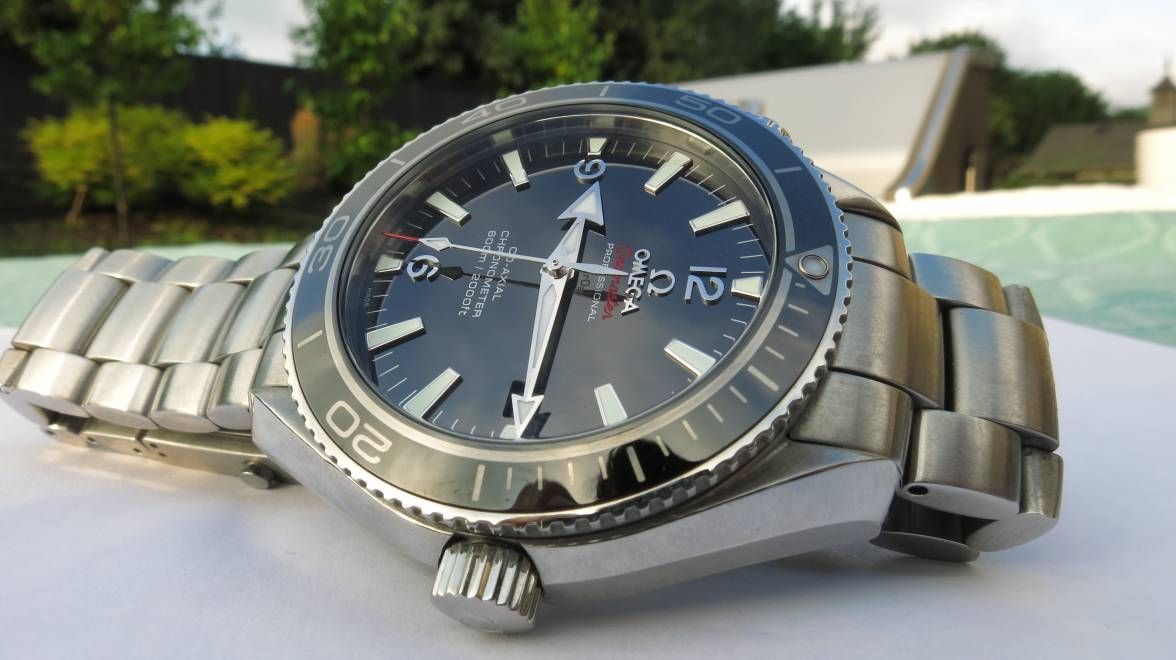
What the Planet Ocean does carry over from the Bond Seamaster, however, is the manually operated helium escape valve which you'll never use but is part of the whole professional diver aesthetic. The Planet Ocean also carries a somewhat larger, also more Speedmaster Pro style knurled crown rather than the smaller Seamaster Pro 300M crown.
The case-back of these Calibre 2500 powered Planet Oceans is an all steel design with the famous Omega "hippocampus" Seamaster logo machines into the surface. While there is no display-back option like on the Calibre 8500 Planet Oceans, this caseback contributes to the relatively thin 14.5 mm overall case height by ensuring impressive water resistance without taking up much vertical space. The LiquidMetal Limited Edition case-back varies a small amount from the regular Planet Ocean 2500 in that it carries the limited edition number out of 1846 around the outer edge, along with the Liquidmetal Technologies logo, and the phrase World Premiere Ceramic [ZrO2]. It's quite a nice choice by Omega to keep all of this to the case-back and in doing so, keeping the dial clean and un-cluttered.
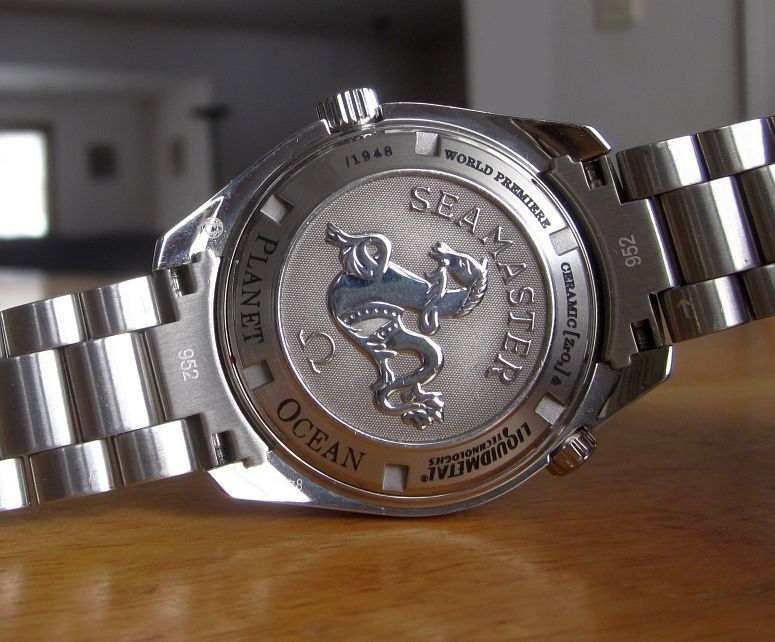
The Planet Ocean bracelet is simple, comfortable, durable and easily maintainable. It features a pin and bushing adjustment system with half-links similar to the Bond and Speedmaster bracelets of that era, along with an identical clasp to the Seamaster Pro 300M with diving extension and the addition of the text Planet Ocean to the clasp.
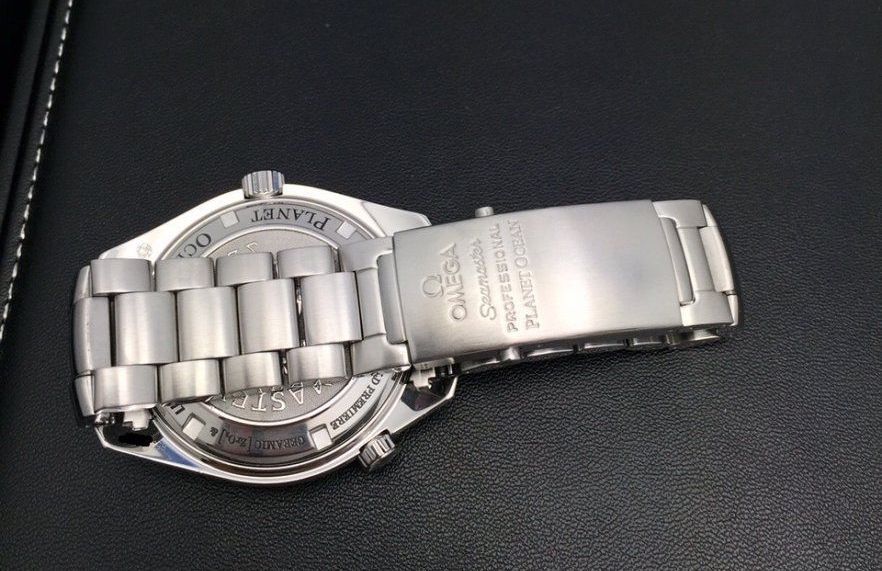
Due to the links and clasp being entirely brushed, any minor swirls and scratches they collect can be rectified relatively easily without the need for professional assistance. Even with some scratches it tends to still look respectable in a utilitarian tool watch kind of way and doesn't look rough like some polished bracelets do in a short period of time. The bracelet as a whole is very comfortable on the wrist, not known to be a hair puller and is non-self-marking, meaning it can be placed down without scratching itself or the case-back.
Movement
The movement powering the Liquidmetal LE is the Calibre 2500, specifically a late production, either Calibre 2500C or 2500D.
These movements were produced for a very long time, since since first appearing in the late 1990's and were used in the majority of Omega's models over the following decade. The particular advantage offered by the Cal 2500 is that while it is an accurate chronometer rated movement, it also fits into a very small footprint being just over 25.6 mm in diameter and an impressive 4.1 mm thick. The compact dimensions of the this movement allowed for the packaging of a 600M water resistant heavy duty dive watch into a watch only 14.5 mm thick, 1.2 mm thinner than the Calibre 8500 Planet Oceans that would follow.
Both the C & D variant of the calibre oscillate at 25,200 vph as opposed to the 28,800 vph of earlier Cal 2500 variants and feature a 48 hour power reserve, up form 44 on the A & B variants.

The key difference between the Calibre 2500 C & D variants is the design of the escapement. The later Calibre 2500D movements utilise a 3-level co-axial escapement, which is actually the original design George Daniels intended for this escapement while all earlier versions including Calibre 2500C utilise a 2-level co-axial escapement. The two-level design was developed to keep thickness down as much as possible and unfortunately this compromise led to issues that required several attempts to address.
The ultimate solution for the Calibre 2500C movement was an upgrade package Omega developed with some new parts and new procedures to follow in servicing. After this solution is applied, the movement stopping issue is effectively resolved to the extent that it will no longer be the limiting factor that brings the watch in for service. All Liquidmetal LE Planet Oceans by now have either had at least one service or are overdue for a service, so it is likely that they either have this upgrade or will receive it when they are sent in. Any qualified watchmaker with access to an Omega parts account will have the ability to apply this during service as will Omega if a factory service is sought.

The Calibre 2500D just seems to run like a top, has no real issues and runs very reliably and accurately. There is no real way to identify whether you have a Calibre 2500C or D externally without examining the movement or running the serial number. That said, while it is good to be aware of these issues, there is no reason to be afraid of them.
Given the prices these watches command and how special they are, simply factor in a full service irrespective of whether the movement is Calibre 2500 C or D, as both will require it after this many years and then enjoy your watch. Both movements, fresh from a watchmaker will be extremely accurate, reliable and dependable so spend the money to service your Liquidmetal Planet Ocean and wear it without worry!
Dial & Bezel
The dial and bezel are what sets this watch apart from every Omega produced before it. They are beautiful, exceptional, extremely photogenic and even stand up well under magnification.
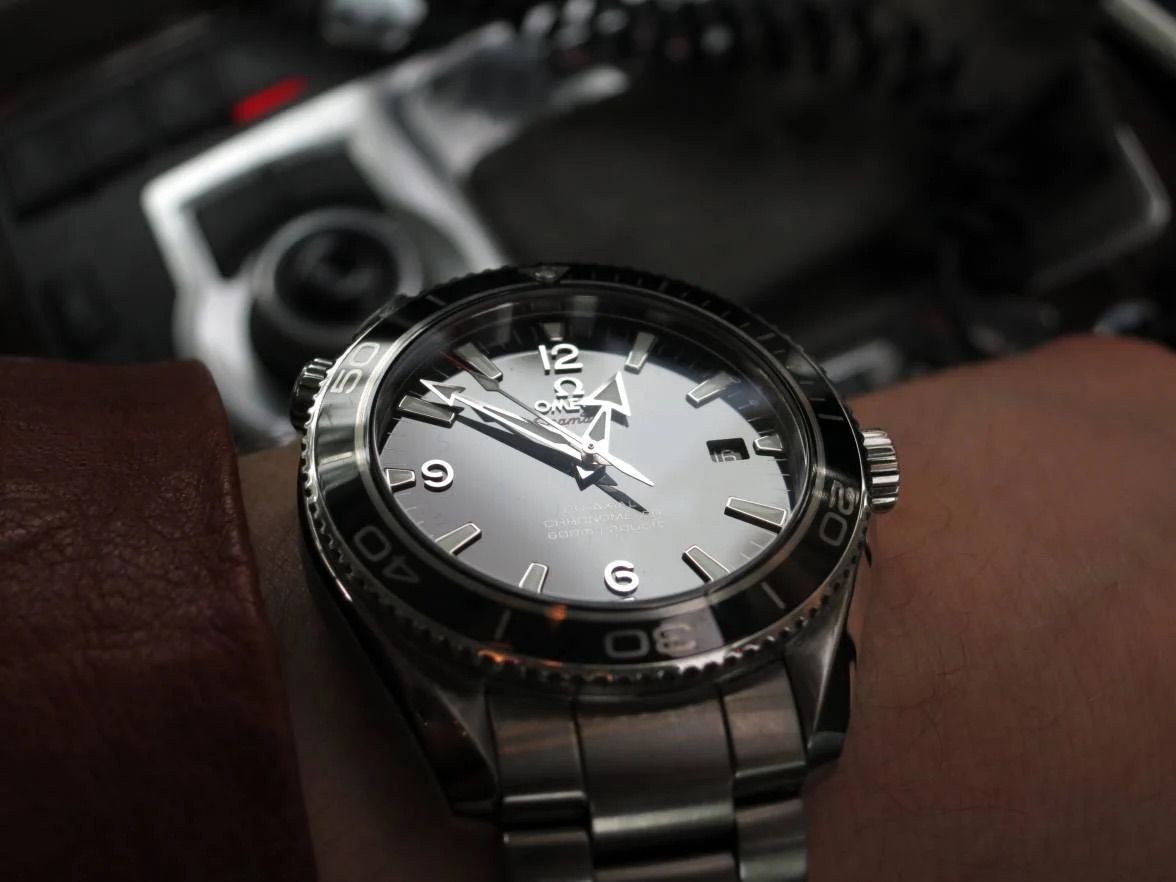
The surface of the dial is made of black colored Zirconium Dioxide (ZrO2) and it is simply spectacular, flawlessly smooth and subtly reflective like a deep black mirror. The applied white gold dial furniture is brilliantly finished and the way they appear to float on the surface of the dial, like boats on a perfectly flat, still, lake on a moonless night will have you staring at this watch every time a new source of light touches it.
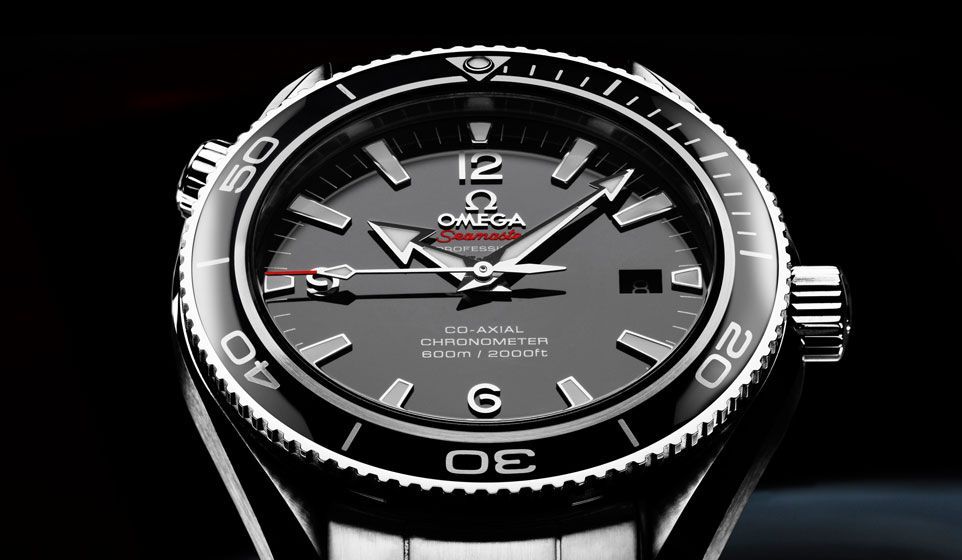
One other particularly nice touch on the Liquidmetal LE is that the applied Arabic numbers at at 6, 9 & 12 retain the open 6 & 9 of the earlier Planet Oceans, which subtly differentiates it from all of the Planet Oceans that came after it. This open 6 & 9 has only recently been embraced again by Omega on the refreshed Seamaster 300.
The double anti-reflective coating (both inside and outside) of the crystal makes it disappear to the eye so much so that it feels like you could reach out and smudge the surface of that perfect dial with your own fingerprints, should you feel like it.
Even the text on the dial has a character and depth not previously seen, especially the red Seamaster text which floats against the sea of black while standing quite proud of the surface.

The bezel is perfectly color matched to the dial, made from the same black Zirconium Dioxide ceramic and unlike previous generations, this bezel will never fade with time. The process which lays the Liquidmetal into the bezel is incredibly impressive, to both the eye and the touch you cannot tell where the ZrO2 ends and the Liquidmetal begins. That perfectly flush design, which then blends in with the curve of the domed crystal bodes very well for long term durability of these bezels and indeed they have held up extremely well over the last 13 years.
Buying
Acquiring a Planet Ocean LMLE is a task requiring either a lot of money or slightly less money and a lot of patience. The reference 222.30.42.20.01.001 was only produced in 1948 units and even when new people realised how special this watch was, to the extent that they were selling above MSRP while still being made and delivered to boutiques as demand outstripped production rate.
Today a BNIB example of the original Liquid Metal Limited Edition with full set is hard to find, and if you do find one, expect it to be very costly, easily over $10,000. The PO LM LE has the distinction of being both a limited collector's item, as well as a superb daily wear watch. As a result there are also some very decent worn examples at a much more reasonable price point. If you don't mind some scratches and swirls and are not strict on having a full set, $6,500 or less can still get you a clean example that will look brilliant on the wrist.
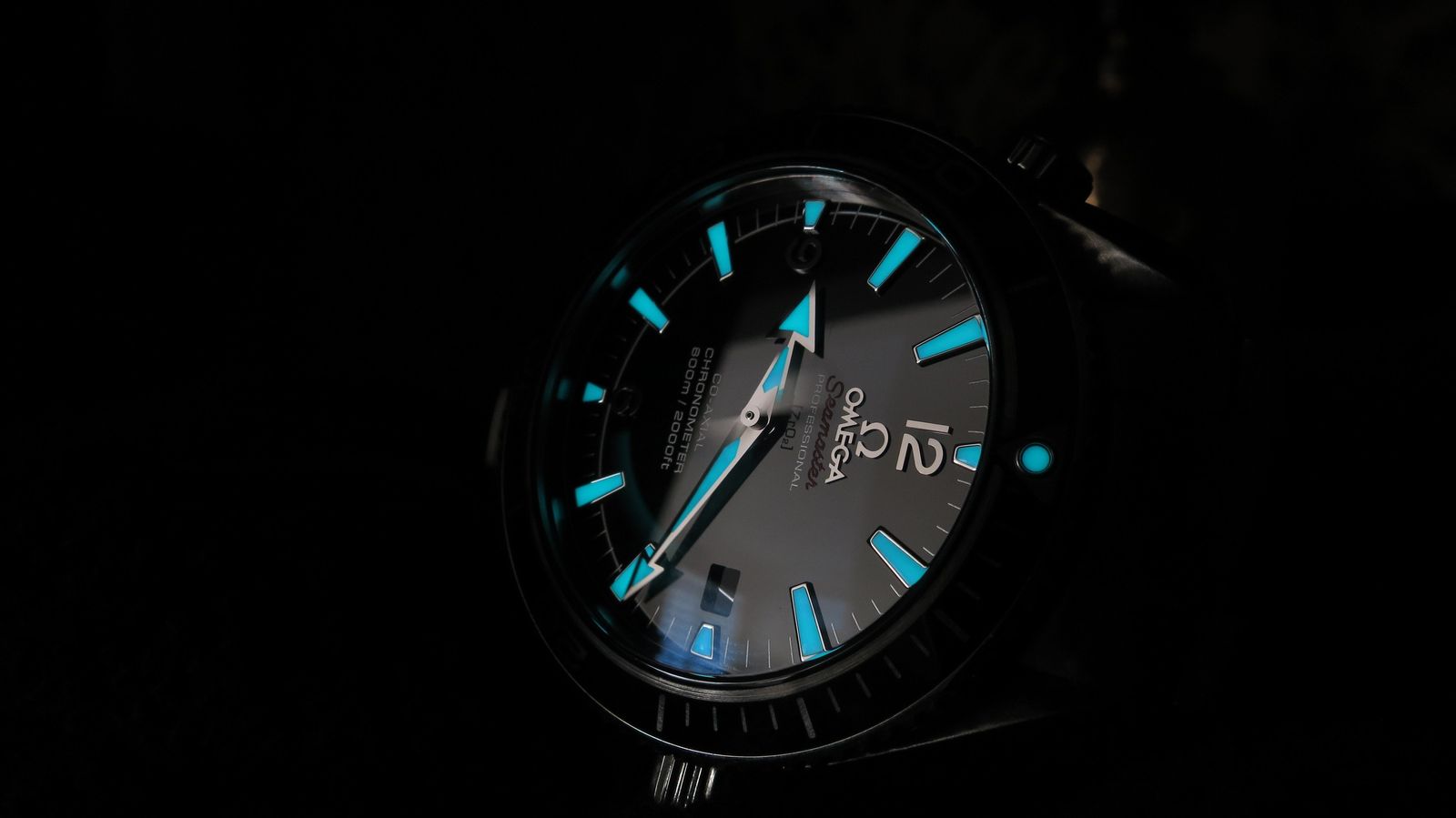
Image by @Superdoc
One of the best things about this watch is how it takes wear without looking rough or worn out. The Planet Ocean bracelet is entirely brushed, easy to re-finish and incredibly solid, while the case is similarly robust. When purchasing, don't be too put off by minor wear like scratches or scuffs. Simply factor a full service into your budget regardless and allow Omega to send the watch back looking brand new again.
In terms of where to buy, your best bet is going to be forums as these are extremely popular and beloved by collectors and the best deals for nicely kept watches will be there. It may take some time to find the right one at the right price on the forum classifieds so if you are a bit more impatient, Chrono24 does typically have a dozen or so at any given point in time although the prices may be a bit higher for the same condition than a private sale. These watches can occasionally be found on eBay but due to the value, and eBay's new fee structure, most people tend to avoid it for watches this expensive so it doesn't tend to be the best choice.
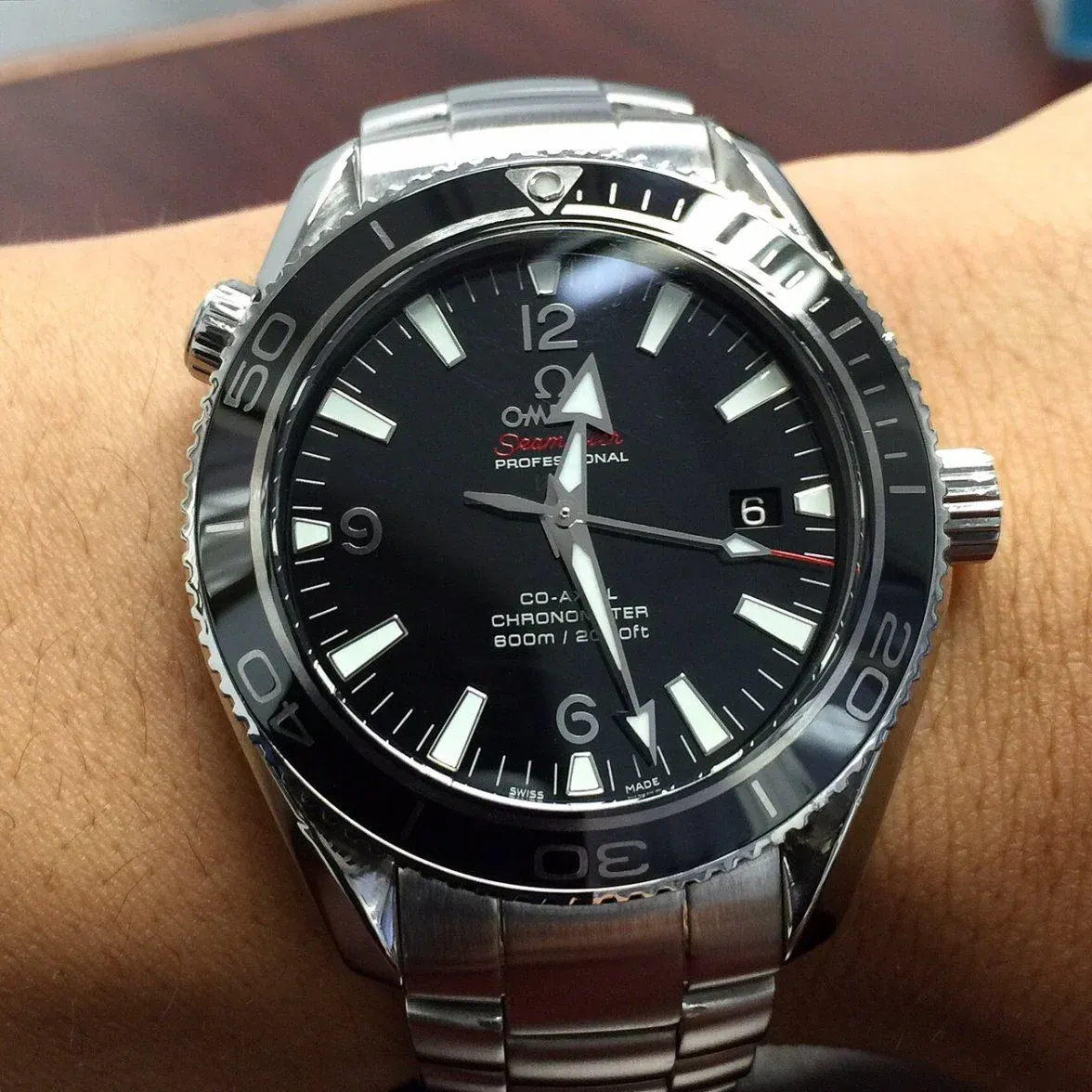
This really is a watch that countless collectors have regretted ever selling and countless more wish that they owned. In terms of the quality, the historical significance, and the beauty of the watch, it is hard to find any diver to match it even more than a decade later. Simply superb, and the best Planet Ocean model ever made.
Discussion thread on Omegaforums can be found here:
